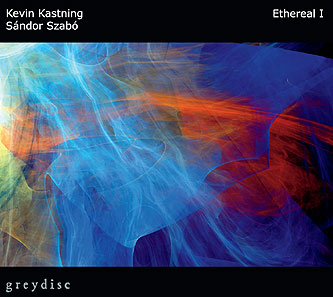 In
2017, guitar explorers Kevin Kastning and Sándor
Szabó teamed for their duo album Invocation. That
79-minute album fittingly followed in the footsteps of their earlier
releases, all of which are available on CD from the Greydisc label.
Kevin and Sándor now take listeners in a completely different
direction with the 2018 CD release of Ethereal I. For Ethereal
I, Kevin and Sándor open the sonic floodgates of guitar-centric
creativity and the results will amaze even long time fans. As he's
done with another guitar collaborator, Mark Wingfield, Kevin pairs
his world-renowned 36-string Double Contraguitar, his 30-string Contra-Alto
guitar and his piano with Sándor’s electric and baritone
electric guitars. The results on Ethereal I are truly stunning
and the 76 minute album takes their sound one step beyond what long
term Kastning fans may have expected. In addition to his avant-garde
approach to using these most unusual sounding and looking 30 and 36
string guitars, Kevin is also quite an effective pianist. Paired with
Sándor’s truly exotic sounding electric guitars, the results
make Ethereal I sound almost otherworldly. True to his eclectic
nature and background, Kevin Kastning has always been an advocate
of progressive rock, classical and jazz guitar and true to form, Ethereal
I incorporates certain sonic elements that are bound to please
certain open-minded members of the prog guitar community. Speaking
about the change of sonic vistas between Invocation and the
2018 release of Ethereal I, Kevin explains, “Invocation
was all-acoustic and was recorded as we usually do, which is a live
and improvised performance. For Ethereal I, Sándor moved from
acoustic to electric guitars. But the difference doesn’t stop
there; he is processing his electric guitar voice to be entirely unique
and unlike anything I’ve heard.” Sándor’s
move from acoustic guitars to processed electric guitars may startle
some purists, especially those who’ve enjoyed the duo’s
previous Greydisc albums. That being said, from a fresh and open-minded
musical perspective, Ethereal I clearly expands upon their
sound in a most satisfying and stimulating way. Speaking about this
unique change of musical scenery, Sándor clarifies, “I
think the unusual part of the Ethereal I is mainly from me. I play
electric guitar and a lot of live and studio processing. I asked Kevin
about the possibility to try how my new electric soundscapes would
sound together with his new carbon acoustic guitars. Kevin is a very
open-minded person to new and unusual ideas, so we made a track and
he liked it so much that with this, a new kind of musical collaboration
started between us.” Fans who enjoyed earlier CD releases
by Sándor and Kevin will be in for a most welcome surprise
with the 2018 CD release of Ethereal I. In a world of musicians
too often apprehensive about altering their recorded sound, or to
set sail upon challenging musical destinations, Kevin Kastning and
Sándor Szabó continue to breathe inspiring and intriguing
life into the art of the guitar and its endless myriad of sonic complexities.
www.kevinkastning.com
/ www.sándorszabó.com
In
2017, guitar explorers Kevin Kastning and Sándor
Szabó teamed for their duo album Invocation. That
79-minute album fittingly followed in the footsteps of their earlier
releases, all of which are available on CD from the Greydisc label.
Kevin and Sándor now take listeners in a completely different
direction with the 2018 CD release of Ethereal I. For Ethereal
I, Kevin and Sándor open the sonic floodgates of guitar-centric
creativity and the results will amaze even long time fans. As he's
done with another guitar collaborator, Mark Wingfield, Kevin pairs
his world-renowned 36-string Double Contraguitar, his 30-string Contra-Alto
guitar and his piano with Sándor’s electric and baritone
electric guitars. The results on Ethereal I are truly stunning
and the 76 minute album takes their sound one step beyond what long
term Kastning fans may have expected. In addition to his avant-garde
approach to using these most unusual sounding and looking 30 and 36
string guitars, Kevin is also quite an effective pianist. Paired with
Sándor’s truly exotic sounding electric guitars, the results
make Ethereal I sound almost otherworldly. True to his eclectic
nature and background, Kevin Kastning has always been an advocate
of progressive rock, classical and jazz guitar and true to form, Ethereal
I incorporates certain sonic elements that are bound to please
certain open-minded members of the prog guitar community. Speaking
about the change of sonic vistas between Invocation and the
2018 release of Ethereal I, Kevin explains, “Invocation
was all-acoustic and was recorded as we usually do, which is a live
and improvised performance. For Ethereal I, Sándor moved from
acoustic to electric guitars. But the difference doesn’t stop
there; he is processing his electric guitar voice to be entirely unique
and unlike anything I’ve heard.” Sándor’s
move from acoustic guitars to processed electric guitars may startle
some purists, especially those who’ve enjoyed the duo’s
previous Greydisc albums. That being said, from a fresh and open-minded
musical perspective, Ethereal I clearly expands upon their
sound in a most satisfying and stimulating way. Speaking about this
unique change of musical scenery, Sándor clarifies, “I
think the unusual part of the Ethereal I is mainly from me. I play
electric guitar and a lot of live and studio processing. I asked Kevin
about the possibility to try how my new electric soundscapes would
sound together with his new carbon acoustic guitars. Kevin is a very
open-minded person to new and unusual ideas, so we made a track and
he liked it so much that with this, a new kind of musical collaboration
started between us.” Fans who enjoyed earlier CD releases
by Sándor and Kevin will be in for a most welcome surprise
with the 2018 CD release of Ethereal I. In a world of musicians
too often apprehensive about altering their recorded sound, or to
set sail upon challenging musical destinations, Kevin Kastning and
Sándor Szabó continue to breathe inspiring and intriguing
life into the art of the guitar and its endless myriad of sonic complexities.
www.kevinkastning.com
/ www.sándorszabó.com
mwe3.com presents an interview with
Kevin Kastning and Sándor Szabó
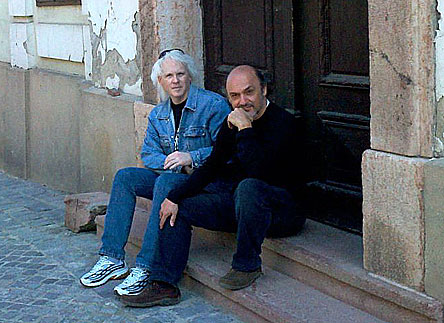 mwe3:
Your 2017 album Ethereal I just came out in early January 2018.
It sounds even more “ethereal” than your last album from
2017 called Invocation. How are the two albums different or
related in some ways and are you walking down new sonic roads or bringing
some fresh perspectives to the Ethereal 1 sound and vision?
mwe3:
Your 2017 album Ethereal I just came out in early January 2018.
It sounds even more “ethereal” than your last album from
2017 called Invocation. How are the two albums different or
related in some ways and are you walking down new sonic roads or bringing
some fresh perspectives to the Ethereal 1 sound and vision?
Kevin Kastning: I don’t think Ethereal I is related
to Invocation in any way. Invocation was all-acoustic
and was recorded as we usually do, which is a live and improvised
performance. For Ethereal I, Sándor moved from acoustic
to electric guitars. But the difference doesn’t stop there; he
is processing his electric guitar voice to be entirely unique and
unlike anything I’ve heard. So not only is the instrumentation
new for us, but his guitars on this record are entirely new within
themselves as well. To do this, we had to change our approach to fit
the requirements of such a new and different instrument in our duo,
and for me to support that voice. I had to create a new and supportive
environment for these new colors and textures. This has resulted in
different compositional directions and approaches, as we knew it would.
So yes, this is certainly a new direction for us. And also the start
of a new direction…
Sándor Szabó: I think the unusual part of the
Ethereal I is mainly from me. I play electric guitar and a
lot of live and studio processing. Though my name became known as
an acoustic guitar player, I always had electric guitars and 2 decades
ago I made an electric album called Echolocation I. Last year
I finished the mixing of Echolocation II. I showed it to Kevin
and he liked it a lot. Then I asked him about the possibility to try
how my new electric soundscapes would sound together with his new
carbon acoustic guitars. Kevin is a very open-minded person to new
and unusual ideas so we made a track and he liked it so much that
with this a new kind of musical collaboration started between us.
We extended our sonic palette with modern electronic guitar soundscapes.
mwe3: Was there anything unique about the studio set up during
the recording of Ethereal 1 and/or was anything done to the
music in the post-production to give it some different kind of sound,
say compared with your earlier releases? Did Sándor use any
pedals or effects to give his electric guitar some unique sounds and
is the electric guitar something he’s been wanting to bring out
on one of your albums?
Kevin Kastning: My studio setup was the same. Sándor’s
setup changed quite a bit…
Sándor Szabó: The recordings happened in the
same way as before the only difference was that I played exclusively
electric guitars, a Burns Barracuda Baritone and a Duesenberg Starplayer
with modified pickups. For the basic sound and harmonizing, I use
a TC G Force rack multi-effect and a Strymon Timeline loaded with
my own custom made algorithms. I never use pedals except the Strymon,
which has the same quality as a rack effect. In the studio I use very
sophisticated high-end reverbs and effects, like the Bricasti M7,
Quantec 2498, Eventide DSP 7500, and some really crazy new plugins.
From the beginning I had my first electric guitar I wanted to bring
out a new sound which nobody else uses. I started to study how to
create new effect algorithms. All the sounds you can hear on the album
are created by me and they are cannot be found in those units as factory
presets.
My specialty is creating different harmonizer algorithms. Over the
music I wanted to create more, to illustrate things in the stereo
field which are not so usual in these days. Ethereal I has
a sonic conception: using spaces, the different musical happenings
on the instruments are placed in different space layers. The space
is dynamic… I created waving, moving atmospheres, so the sound
is kind of like a living being.
mwe3: The cover art for both Ethereal 1 and the earlier
Invocation are both very colorful. What can you tell us about
the two different cover arts and artists behind them?
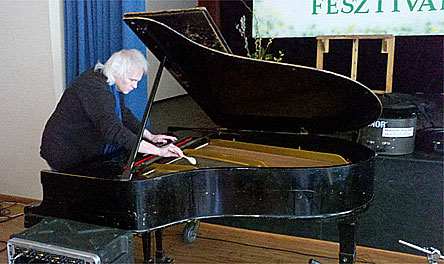 Kevin
Kastning: Cover art is always difficult. It is very arduous to
find something in visual art to represent, tie-in, or otherwise connect
with an aural art. For me, finding the right cover art is one of the
most time-consuming parts of the album process. The cover for Invocation
was shot in the Himalayas, near Mt. Everest, in 2016 by the wonderful
Hungarian photographer Laszlo Hutton. That cover is a photo of prayer
flags outside a Buddhist monastery in Tibet. The color and movement
of the flags had, for me, a connection to the feel of the pieces on
Invocation. The composition titles on Invocation all
refer to prayers or types of prayers, and that was also a tangible
connection to and representation of the prayer flags. Also, the motion
in that photo is palpable, and I felt a connection with that motion
and the movement within the pieces on Invocation.
Kevin
Kastning: Cover art is always difficult. It is very arduous to
find something in visual art to represent, tie-in, or otherwise connect
with an aural art. For me, finding the right cover art is one of the
most time-consuming parts of the album process. The cover for Invocation
was shot in the Himalayas, near Mt. Everest, in 2016 by the wonderful
Hungarian photographer Laszlo Hutton. That cover is a photo of prayer
flags outside a Buddhist monastery in Tibet. The color and movement
of the flags had, for me, a connection to the feel of the pieces on
Invocation. The composition titles on Invocation all
refer to prayers or types of prayers, and that was also a tangible
connection to and representation of the prayer flags. Also, the motion
in that photo is palpable, and I felt a connection with that motion
and the movement within the pieces on Invocation.
For Ethereal I, the cover was done by French artist Tim
Paulve. Tim is quite an original artist, who also created the cover
art for Skyfields, my second solo record. The colors, textures,
and movement of that piece of Tim’s art represented to me almost
a visual, tangible, interpretation of the pieces of Ethereal I,
and to my way of thinking, that piece of art has its own inherent
ethereal qualities as well. My sincere gratitude to both Laszlo and
Tim for their support in allowing us to use their beautiful work.
Sándor Szabó: As always I leave the cover design
to Kevin. When he makes the mockups he sends me some versions and
we discuss and choose the proper one, which expresses the music. In
this album we really created a lot of new colors in the music and
this is why we needed a new colorful cover.
mwe3: Is there a story behind the lead off track “Choros
Nympharum”? How did you come up with that title and why did you
choose to start the CD with that track? You can really hear the unique
interplay between the 36-string and Sándor’s baritone
electric guitar sound. Did Sándor try to lay down a kind of
sonic carpet for Kevin to punctuate that track with the 36 string
and would you say that track almost sounds like a synthesized backing
which, in turn, offers a striking contrast to the 36 string Double-Contraguitar?
Kevin Kastning: That was the opening track because we felt
that it had a kind of introductory or mysterious overview atmosphere…
a kind of introduction to this new sound world. There are no synthesizers,
either keyboard or guitar, on this album.
Sándor Szabó: When we record we have a certain
basic musical material from the instruments which, from my part, includes
some effects but after that in post-production, I create even more.
Sometimes the sonic carpet gets laid behind the solo instrument. Just
to avoid misunderstandings, we never use synthesizers in any form.
All the electronic soundscapes are created by the sound of vibrating
strings, no samples, and no MIDI. They are kind of handcrafted electric
guitar-based sounds using special studio hardware effects and plugins.
mwe3: Kevin also plays piano quite a bit on Ethereal 1 and
it offers a wonderful balance to the guitar sound. What instruments
are you playing on “The leaves are full of voices”? It also
sounds like there’s some guitar volume swells on that track.
What piano and what guitars are featured on “The leaves are full
of voices”? It’s a very suspenseful sounding track and in
fact, all the tracks have high levels of sonic suspense.
Kevin Kastning: I am playing a Kawaii grand piano on that piece.
I concur; the piano brings a very sharp contrast to Sándor’s
instruments on this album. I think the two instruments blend very
well and provide yet another texture and palette. My acoustic guitar
voices also blend and contrast very well with Sándor’s
electric instruments, but the piano is another very different; yet
equal, contrast. The piano pieces seem to carry a kind of atmospheric
environment with them, which again provides an ideal and fitting canvas
for Sándor and thus for the compositional structure.
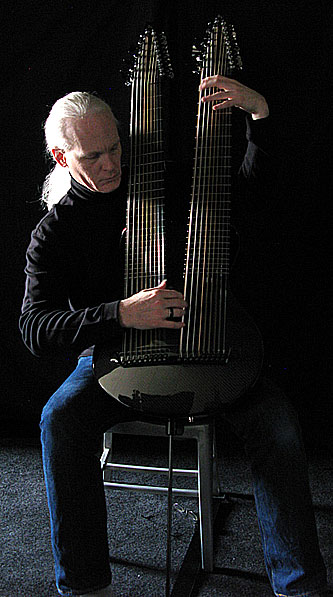 Sándor
Szabó: Piano and electric guitar can work very well in
the music even with a lot of processing. This kind of soundscape is
not typical at all in the so called New Age or ambient music, though
the piano and the synth are basic tools. We did not want to play New
Age or ambient music, we wanted to surf above the trends and creating
new things in our style. I wanted to try how a processed guitar sound
can merge into a warm acoustic piano sound.
Sándor
Szabó: Piano and electric guitar can work very well in
the music even with a lot of processing. This kind of soundscape is
not typical at all in the so called New Age or ambient music, though
the piano and the synth are basic tools. We did not want to play New
Age or ambient music, we wanted to surf above the trends and creating
new things in our style. I wanted to try how a processed guitar sound
can merge into a warm acoustic piano sound.
mwe3: “And in the water” is a kind of musical conversation
between two guitarists who are quite familiar with each other’s
sound. So, is “And in the water” a kind of guitar conversation
between two musicians clearly on the same wavelength and how did Sandor
treat his guitar sound on that track?
Sándor Szabó: All the atmospheres are reverb-based
and as such are quite complicated. Some of them stand up 4-6 stereo
layers. I use some new reverb plugins especially designed for electric
soundscapes and atmospheres. I also used some preparation on my Burns
guitar so this is why it sounds so otherworldly.
mwe3: How did you come up with the title for “For which
the stone is cut”? Sandor’s guitar almost sounds like an
organ at times. That track seems a little more chilling compared to
the first three tracks.
Kevin Kastning: The opening of that piece starts off with some
cluster-voiced chords that I’m doing on 36-string, and then Sándor’s
part reflects that eeriness, and I think this permeates the entire
piece. The titles on this album are a bit unusual, even for me. The
opening and closing tracks have connected titles to illustrate the
opening and closing of the album, like an introduction and a conclusion.
Titles for the other pieces, tracks 2 – 9, are actually an eight-line
poem. Each title is a line in the poem. So not only are the titles
interconnected; in fact, tracks 2 – 9 are almost one single title,
but the tracks are connected in this manner to further illustrate
the overall structure of this record. I leave it to each listener
to determine their own meaning or interpretation of possible hidden
meanings in each title.
Sándor Szabó: My most important sound device
is a simple analog volume pedal. It cuts down the transient of the
guitar sound and then I can form the guitar sound in different ways.
It is quite easy to make organ-like sounds. I also have a conceptual
restriction in that I do not use distorted sounds, not because I do
not like it, but now the guitar world lives almost in the distorted
sound world, which creates a lot of limitations in the overall sound.
I want to create more ethereal things with extended polyphony. The
distorted sounds works like an icon, they predestinate the listener
from the very first second. There are people, who cannot imagine modern
music without distorted guitar. I think in music, and for that purpose,
I need an extended polyphony, which cannot be made with distorted
guitar sound. As I mentioned I use harmonizers but in this music they
have another function: they are compositional tools to build never
heard, unpredictable chord progressions for the melodic lines.
mwe3: “Drift under hills” has some unique melodic
ideas which sort of rubs up against the more atonal or avant-garde
nature of your music. Again, Sandor’s electric guitar sounds
very intricate in places. Is “Drift under hills” one of
the more New Age or meditative type tracks on Ethereal 1? It’s
a definite highlight on the album. It’s hard to believe it was
all done live right?
Kevin Kastning: In the realm of our music, I usually shy away
from categorical labels such as New Age or jazz, or whatever it may
be. I have no issues with New Age music; in fact, there is some of
it that I quite like. Sándor and I don’t think in terms
of genre when planning out a new album project. Genre classifications
matter not at all to us. In other words, we don’t say ‘Let’s
make this more of a New Age record,’ we just plan the direction
of the pieces and then follow that mapping or structure, and allow
the project to organically grow and expand. If someone hears it as
New Age, or jazz, or however they are hearing it, that’s fine.
With this kind of music, it’s kind-of genre agnostic, and therefore
lends itself to being thought of in different camps I suppose.
I suppose it is again up to each listener to determine if a piece
is meditative for them. I can hear that element in the piece, but
the piece wasn’t planned to be meditative. And I think the matter
of meditative qualities in a piece of music is largely determined
or decided by each listener. In other words, there is music that I
find meditative that you might not at all. Which is fine; this is
part of the magic of music: it can mean something different to each
person, yet no meanings or interpretations are wrong.
Sándor Szabó: No, it was not all done live. After
recording the basic material, I started to create a structured musical
architecture. For this I had to make some overdubs to put the right
layers to the right place. This is serious creative studio work. I
could say that I continued the composing in the studio after all this,
significantly more than making a simple duo recording.
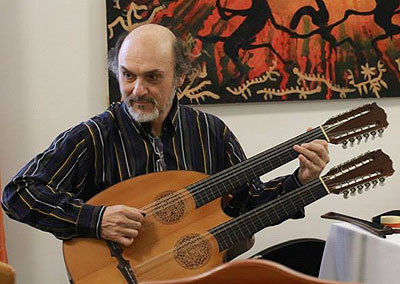 mwe3:
“Spoken by wind” is another piano-centric track with a unique
melodic edge. How does the piano add a melodic contrast to the guitar
sound? Is “Spoken by wind” another kind of meditative New
Age type of track, considering it’s kind of harmonious in a way.
mwe3:
“Spoken by wind” is another piano-centric track with a unique
melodic edge. How does the piano add a melodic contrast to the guitar
sound? Is “Spoken by wind” another kind of meditative New
Age type of track, considering it’s kind of harmonious in a way.
Kevin Kastning: I’ve been starting to incorporate more
piano into the projects where it fits. I played piano on almost half
of the latest album with Mark Wingfield, “The Line To Three.”
It really brings other colors, textures, and compositional environments
into a piece, when the piece is right for it. This was one of those
pieces. Oddly enough, or maybe it is only odd to me, but playing piano
on a studio date doesn’t feel that much different from playing
guitar on a studio date. The process is always the same: to be in
service to the music, and that’s still true no matter the instrument.
Sándor Szabó: Well, we do not think in terms
of so-called New Age music. In the moment when a musician or composer
starts to use this term, it’s unconsciously committed to a trend,
a fashion and a want to correspond to all the parameters of the so-called
New Age style or genre. We just try to recall and create what we hear
inside. The New Age music in general uses simple chords and melodies.
Following that would be too big restriction for us musically in spite
of that sometimes we use simple chords and melodies, but in another
way. Why you hear this piece sounding like a kind of New Age music
is that it sounds a little minimalist, and it has a very definite
tonal center, which can remind you of some New Age music. For us,
the modal or chromatic sounds are equal compositional tools. We use
them without thinking of any styles or genres.
mwe3: What can you say about “The eyes of day”, especially
as it’s one of the longest tracks on Ethereal 1? Is that
the 30 or 36 string on that track? What can you say about the chord
patterns on that track and some of the musical ideas that came into
play on “The eyes of day”?
Kevin Kastning: That is the 30-string on that piece. I was
trying to create a sense of space, an openness, both harmonically
and structurally. From there, the piece took on a life of its own.
I really had no idea of its melodicism until I heard the rough mixes
in post-production.
Sándor Szabó: Kevin composed the chord progression
in a very airy way to leave space for the listener to really deeply
immerse in the mood of those mystical chords. I decided to overdub
a special melody to fill out the space between those pentonal chords.
My intention was to surf above those chords to create a floating tonal
tension. Finally, it became a very organic conversation between the
instruments.
mwe3: “You never seem to have discovered” is a unique
title. How does that title fit the music? That’s another track
with those incredible volume swells that are punctuated by the 36-string.
Anyone who doubts the veracity behind your music should listen to
that track.
Kevin Kastning: You never seem to have discovered is
the seventh line in the eight-line poem that is the titling structure
of tracks 2 – 9. I won’t say how I think the title fits
the music in this piece, but will instead leave it up to each listener
to find a connection… or not!
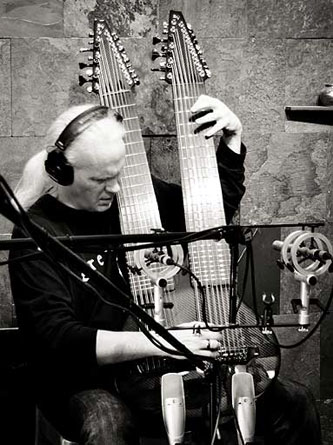 Sándor
Szabó: Well, when I saw this title I did not really know
what was in Kevin’s mind, but I can associate to the fact that
the more valuable music we create, the less is the chance to be discovered.
The expression itself “to be discovered” is from the music
industry, for musicians and composers who follow a trend and hoping
that one day they will be discovered by a producer or manager or a
label. This is not our world. We are artists and what we do, we have
to do… the music has to happen and put into the world. We do
not want to entertain people, the music is not for that in our world.
The music is a sacred activity and kind of communication, but always
art. So this is how I can translate that title.
Sándor
Szabó: Well, when I saw this title I did not really know
what was in Kevin’s mind, but I can associate to the fact that
the more valuable music we create, the less is the chance to be discovered.
The expression itself “to be discovered” is from the music
industry, for musicians and composers who follow a trend and hoping
that one day they will be discovered by a producer or manager or a
label. This is not our world. We are artists and what we do, we have
to do… the music has to happen and put into the world. We do
not want to entertain people, the music is not for that in our world.
The music is a sacred activity and kind of communication, but always
art. So this is how I can translate that title.
mwe3: What can you tell us about “Moves only now and clinging”?
Is the 36-string and 30-string more prevalent on that track? The sonic
chemistry on that track is brilliant as there’s hardly any loose
ends or off notes. The dynamics are perfectly in place on that track,
so do you consider “Moves only now and clinging” one of
the high points on Ethereal 1?
Kevin Kastning: No, that is only the 30-string on that
piece. I hear it as a very atmospheric piece, especially with the
opening chords and harmonics. As to the question of a high point,
again it’s not for me to say. Maybe because there are certain
records where it is almost impossible for me to separate out individual
pieces, and I think Ethereal I is one of those. Instead of
a set of or a collection of pieces, I hear the record as a whole,
the album in its entirety, as one large composition. A singularity.
Similar to a symphony or a classical piece constructed in movements.
Yes, there are individual tracks or movements, but they are only components
of the overall structure and singular composition.
Sándor Szabó: For us, each track means a high
point, each track is our sweet child. It is very subjective for a
listener which one can be the favorite track. When I was working on
the tracks, that track was my favorite at that time, but when I started
another one that became the high point for me. When I finished the
work and I started to listen the whole material after each other,
I was not able to choose a favorite.
mwe3: “Sylva Nympharum” is a bizarre title and it’s
another piano-centric track. It’s also the longest track on Ethereal
I. The piano really adds another dimension to Ethereal I from
start to finish. What brought on “Sylva Nympharum” and how
did that track end up being the final track on the CD?
Kevin Kastning: Sándor asked me to do some pieces on
piano for this album, and that was one of them. It was selected as
the final track because we felt that it had a kind of epilogue-esque
quality. It seems to contain a kind of conclusive feeling within itself.
Sándor Szabó: To be honest, Kevin did not want
to put piano pieces on this album first. When I heard some ideas from
him on piano I convinced him to compose some for the album. One of
my favorite composers is Frederico Mompou. His sparse and unpredictable
musical architectures would be a perfect base for such an electric/acoustic
project. So I asked Kevin to compose some sparse piano music.
mwe3: What else is new for you in the guitar world? I was reading
about the new 17-string Hybrid Extended Classical guitar. What can
Kevin tell us about that guitar? Hard to imagine it uses both nylon
and steel strings or as you call it “courses”. What can
you say about the tunings and sound of the 17 string and what other
instruments are coming up for possible design and recording in the
future?
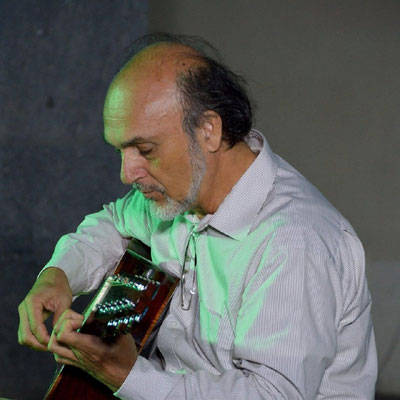 Kevin
Kastning: The 17-string Hybrid Extended Classical guitar just
arrived last week, so I am still very much in the discovery and getting-to-know
it phase. This voice has never existed in the guitar world. The tunings
thus far are all octaves and unisons, but of course that is subject
to change. Before I start experimenting with new tunings, I really
must know the voice of the instrument. When the 15-string Extended
Classical arrived, it took me the better part of a year to learn its
voice; it was and is so very unique and different; equal parts guitar
and lute. The 17-string will require a similar process; it’s
voice is quite unusual, but very beautiful. I expect it will be on
the next solo record.
Kevin
Kastning: The 17-string Hybrid Extended Classical guitar just
arrived last week, so I am still very much in the discovery and getting-to-know
it phase. This voice has never existed in the guitar world. The tunings
thus far are all octaves and unisons, but of course that is subject
to change. Before I start experimenting with new tunings, I really
must know the voice of the instrument. When the 15-string Extended
Classical arrived, it took me the better part of a year to learn its
voice; it was and is so very unique and different; equal parts guitar
and lute. The 17-string will require a similar process; it’s
voice is quite unusual, but very beautiful. I expect it will be on
the next solo record.
As to future instruments, there are two, but I can’t really say
much more about those right now. As for other things new in the guitar
world, I think that what Sándor is doing with his two electrics
is notable. We are already at work on the next two albums in the Ethereal
series, and he has and is going beyond what you hear on Ethereal
I.
Sándor Szabó: Your question is very interesting
if you ask me what is new for me in the guitar world. I was thinking
on how to make a new, never heard clean sound with an electric guitar.
It is difficult, everything is invented and all the guitars sound
practically in the same way. After Bill Frisell’s sound it is
really very hard to find or create a special, original clean voice
for electric guitar. One day a very old recording came across where
I heard a vintage Burns guitar. It was so new to my ears in spite
of that I grew up with the sound of Hank Marvin of The Shadows and
Bo Windberg of The Spotnicks. That very ancient single coil pickup
sound sounded so modern to my ears that I decided to get an original
Burns. When you combine things that are not typical, it always results
in something new. In my case the old Burns sound was combined with
a baritone range and with my finger picking plus the harmonizers and
different delays, reverbs all together.
As for Kevin’s 17-string, it is an amazing, phenomenal guitar,
which blends two very different sounding guitars. The result is something
I never heard, a lute, a harpsichord together, with a very ethereal
sound. I think this new instrument will inspire both of us to create
really new sounding guitar albums.
mwe3: What other projects are both of you exploring for 2018?
Will Ethereal I be a kind of musical template for you as you
consider a follow up? What kind of projects will Sándor be
releasing this year and what other albums are on tap for Kevin’s
Greydisc label for 2018?
Kevin Kastning: Ethereal I is the beginning of an Ethereal
series for us wherein Sándor will be using electric guitars.
And Sándor and I are at work on Ethereal II, which is
not only the follow-up to Ethereal I, but an extension of this
established direction. The wonderful Hungarian percussion artist Balázs
Major will be joining us on Ethereal II. I have had the good
fortune to tour and record with Balázs, and for me, he is not
merely a percussionist; he is a true artist. Even though we are doing
the Ethereal series does not  mean
we won’t be doing further acoustic projects. Sándor and
I are doing a European tour in spring 2018, and the tour will no doubt
include some recording dates. The next record with Mark Wingfield
is completed and ready for release. He and I have recording studio
dates scheduled for August 2018, and at least one new album is likely
from those sessions. Carl Clements and I will be starting on our next
album soon. In fact, there is a trio record of Carl, Sándor,
and I that is recorded and should be released this year. And I am
currently at work on three very different solo album projects.
mean
we won’t be doing further acoustic projects. Sándor and
I are doing a European tour in spring 2018, and the tour will no doubt
include some recording dates. The next record with Mark Wingfield
is completed and ready for release. He and I have recording studio
dates scheduled for August 2018, and at least one new album is likely
from those sessions. Carl Clements and I will be starting on our next
album soon. In fact, there is a trio record of Carl, Sándor,
and I that is recorded and should be released this year. And I am
currently at work on three very different solo album projects.
Sándor Szabó: We started to work on a trio album,
the Ethereal II as a continuation of this album. On that we
want to go even farther in music and sound. We invited the great Hungarian
drummer and percussion player Balázs Major, who keeps some
secret new sounds for the album. I’m working on different other
projects with other Greydisc artists like Mark Wingfield. I just finished
the mix of a quartet album including Mark Wingfield, Balázs
Major, Roland Heidrich and myself. This album will be probably in
the download repertoire of the Greydisc Records. With Kevin we have
a lot of new ideas for future releases but now it would be early to
say anything about them.



